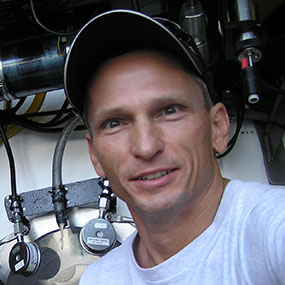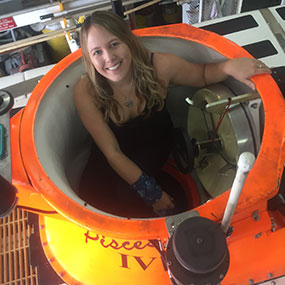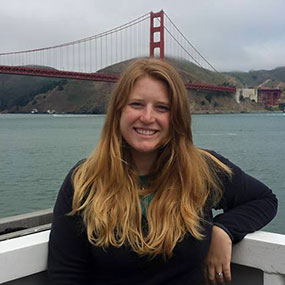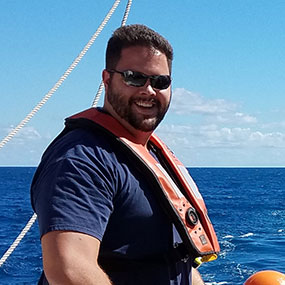
This media resources page provides members of the media with information; resources; and broadcast-, print-, and web-quality imagery developed during the Mountains in the Deep: Exploring the Central Pacific Basin expedition.
From September 6 - 30, NOAA and partners will conduct an ocean exploration expedition on NOAA Ship Okeanos Explorer to collect critical baseline information about unknown and poorly known deepwater areas around the Musicians Seamounts and Hawaiian Islands. The expedition begins and ends in Honolulu, Hawaii.
During the cruise, our at-sea and shore-based science teams will work together to map the seafloor and make deepwater scientific observations in these areas. Live video of remotely operated vehicle (ROV) dives can be viewed online in real time from September 7 - 29.
The ship will conduct 24-hour operations consisting of daytime ROV dives and overnight mapping operations, including during transit. Mapping and ROV dives with high-resolution visual surveys and limited sampling activities will focus on priority dive sites and mapping areas in and around the Musicians Seamounts. Dive sites are expected to include deep-sea coral and sponge habitats and seamounts. This expedition will contribute to foundational information in the region to catalyze further exploration, research, and management activities.
On this page:
Why? | Who? | Highlight Videos & Images | Press Releases | Background Info | Contact Info
The expedition is part of the three-year Campaign to Address the Pacific monument Science, Technology, and Ocean NEeds (CAPSTONE), a foundational science initiative to collect deepwater baseline information to support science and management decisions in and around U.S. marine protected areas in the central and western Pacific. These areas contain some of the last relatively pristine marine ecosystems on the planet and harbor numerous protected species, undiscovered shipwrecks, and cultural landscapes. Their designation is unprecedented in terms of geographic scope, ecological value, and national symbolism for ocean conservation. However, their remoteness creates substantial challenges. Most deepwater areas remain poorly known and are of high interest to federal and state agencies with research and management responsibilities. To address this challenge, NOAA is conducting a series of expeditions aboard NOAA Ship Okeanos Explorer.
Located northwest of the main Hawaiian Islands, the Musicians Seamounts are largely unexplored. Small portions of this 650 nautical mile seamount chain have been previously mapped during transits, but the Deep-Sea Symphony expedition will involve the first dedicated mapping operations and exploration using remotely operated vehicles (ROVs) to increase the understanding of this fascinating region that lies just outside the U.S. exclusive economic zone (EEZ).
Marine animals, such as fish and corals, do not recognize geopolitical boundaries of the world’s ocean. As one of the closest seamount groups to the Hawaiian Islands and the Papahānaumokuākea Marine National Monument, the Musicians Seamounts may serve as refuge for transient fish populations that Hawaii relies upon, provide additional habitat, and serve as a pool of genetic diversity for deep-sea coral populations known from the deep waters around the Hawaiian Archipelago.
Additionally, the Musicians Seamounts offer a unique opportunity to expand geological knowledge of fracture zones and hotspot volcanism and how these features interact in areas where they coexist. Furthermore, this expedition will fill in gaps in data regarding seamount geomorphology and manganese crust accretion.
The Deep-Sea Symphony: Exploring the Musicians Seamounts expedition will address science themes and priority areas put forward by scientists and managers from NOAA, management agencies in the region, and the ocean science community. NOAA priorities for the expedition include a combination of science, education, outreach, and open data objectives that will support management decisions at multiple levels:
This expedition is part of the three-year Campaign to Address the Pacific monument Science, Technology, and Ocean NEeds (CAPSTONE), a foundational science initiative to collect deepwater baseline information to support science and management decisions in and around U.S. marine protected areas in the central and western Pacific. Other 2017 focus areas include National Marine Sanctuary of American Samoa, Rose Atoll Marine National Monument, and the Howland and Baker, Johnston Atoll, and Kingman Reef and Palmyra Atoll Units of the Pacific Remote Islands Marine National Monument, now known as Pacific Islands Heritage Marine National Monument.
The expedition involves a number of NOAA partners including National Marine Fisheries Service's Pacific Islands Fisheries Science Center, Pacific Islands Regional Office, and Office of Habitat Conservation's Deep-sea Coral Research and Technology Program; Office of Marine and Aviation Operations; the National Ocean Service's Office of National Marine Sanctuaries, NESDIS National Centers for Environmental Information; and Office of Oceanic and Atmospheric Research's Office of Ocean Exploration and Research.
The individuals listed below will primarily lead activities during the expedition. They will coordinate input from multiple scientists and managers participating from shore to plan dives and are the voices you hear on the live video feeds and the primary participants in outreach events. For a full list of our on-ship team, please visit this page.

Science Lead, University of Hawaii at Manoa
Dr. John R. Smith has served as the Marine Geophysical Specialist and the Science Program Director for the University of Hawaii Undersea Research Laboratory (HURL). He has used various acoustical and in situ methods to study the seafloor and sub-seafloor in many of the world’s oceans, specializing in multibeam bathymetry and backscatter data collection, processing, and interpretation. His research projects have focused on the mapping of seamounts and the unstable flanks of oceanic islands that can fail and cause tsunamis. Dr. Smith has also become involved in deep and shallow-water benthic habitat mapping in support of fisheries assessment and management, along with other special applied research projects such as environmental and engineering studies prior to seafloor mining, the laying of underwater power cables, and seawater A/C pipelines. As more areas of the high seas have been set aside as marine national monuments or other protected area designations, he has focused on projects in these regions, providing critical baseline and other data to accelerate discovery, delineate features for more targeted study, and assist with resource management.
John received his Bachelor of Science degree in Geological Oceanography from Florida Tech, worked in the offshore petroleum exploration survey industry for several years in the Gulf of Mexico and Caribbean, and then returned to graduate school at the University of Hawaii at Manoa for his Masters and Doctoral degrees, both in Geological Oceanography as well, and eventually a position with HURL. There, he managed the seafloor mapping program; carried out data processing and research; and served in the role of scientific manager, administering all aspects of the science program including peer reviews, panels, scientific equipment upgrades, scheduling of field programs, and functioning as the liaison between scientists, operations, and administration. A bonus of his career path is that he gets to sail to remote areas not often visited, dive in human occupied submersibles, and occasionally operate underwater robotic vehicles.

Science Lead, University of Hawaii at Manoa
Meagan Putts is a deep-sea researcher studying coral and sponge communities. She is part of the experienced team of scientists at the University of Hawaii analyzing data collected by the CAPSTONE project in the Pacific and is leading the effort to make Hawaii Undersea Research Laboratory's (HURL) archive available online. She is also an artist and teacher who enjoys incorporating aspects of marine ecosystems into her artwork. Meagan completed her Masters in Marine Science at Hawaii Pacific University in Honolulu, Hawaii, and her Bachelors of Science in Marine Science and Visual Arts at Eckerd College in St. Petersburg, Florida.
Meagan’s research has been focused on understanding the development and community structure of deep-sea precious coral communities, which led her to her initial work with the Okeanos Explorer. In 2015, she planned and helped orchestrate a dive, via telepresence, off the southern point of Hawaii during the 2015 Hohonu Moana Expedition. She utilized the data collected to compare varying age coral communities on the Hawaiian lava flows. As deep-sea coral species grow at extremely slow rates, research on these lava flows provide a known maximum age for each community since new communities begin to form on top of the lava substrate as soon as it cools. This allows for the examination of community development across longer time scales than would be normally possible within a human lifetime.
This will be Meagan’s third expedition aboard the Okeanos Explorer. She has previously sailed as an Explorer in Training, gaining invaluable experience mapping the deep Pacific seafloor. She is excited to be headed back out to sea as the biology science lead exploring the Musicians Seamounts in this final CAPSTONE mission. In the future, she plans to pursue her Ph.D. and immerse herself in further in her career as a deep-sea benthic ecologist.

Expedition Coordinator, NOAA Office of Ocean Exploration and Research
Kasey Cantwell is a Field Operations Specialist with NOAA's Office of Ocean Exploration and Research (OER). Kasey has a Master of Science degree in Marine Affairs and Policy and Marine Geology and Gepophysics, and a Bachelor of Science degree in Marine Science and Biology, both from the University of Miami Rosenstiel School of Marine and Atmospheric Science. Kasey is responsible for coordinating telepresence-enabled expeditions conducted onboard NOAA Ship Okeanos Explorer. Since joining OER in 2012, she has coordinated over a dozen expeditions and projects, including multidisciplinary expeditions to the Atlantic submarine canyons, the Marianas, Pacific Remote Islands Marine National Monument, and Glacier Bay National Park.
Beyond deep-sea exploration, Kasey’s background includes imagery-based mapping of coral reefs throughout the Caribbean, long-term ecosystem monitoring, and evaluating resource management strategies to improve efficiency and data quality.

Mapping Lead, NOAA Office of Ocean Exploration and Research
A native of Long Island, New York, Mike took a deep interest in ocean science at a young, age growing up in and on the water. After graduating from SUNY Geneseo with a degree in geological sciences, Mike continued his education at the School of Marine and Atmospheric Sciences at Stony Brook University. At Stony Brook, he worked on several projects, including acoustic mapping of coastal areas, coastal sediment management, remote sea level monitoring, submarine groundwater discharge, and applying his GIS proficiencies. Mike’s M.S. thesis focused on the processing of multibeam backscatter and its relationship to the physical characteristics of the seafloor. After completing a graduate certificate in geospatial science and earning a reputation as a reliable field scientist, Mike started a new position as a hydrographic analyst with NOAA’s Sandy Integrated Ocean and Coastal Mapping team at the Center for Coastal and Ocean Mapping (CCOM) at UNH. At CCOM Mike processed outside to NOAA hydrographic datasets, examined additional applications for topobathymetric lidar, collaborated on a seafloor imaging device, and served as a physical scientist supporting hydrographic surveys. As the newest member of the Okeanos Mapping Team, Mike is truly excited to support their mission exploring the oceans. During his off hours, Mike can be found cooking, hiking, or watching movies.
Dive highlight videos, short video clips, and photos will be posted online as they are available.
Please contact Katie Wagner for high-res footage, B-roll, and other materials at (301) 734-1008 or Katie.Wagner@noaa.gov.
Access LIVE video feeds here
Expedition home page
NOAA ship journeys into remote, deep Pacific ocean
February 14 - NOAA News